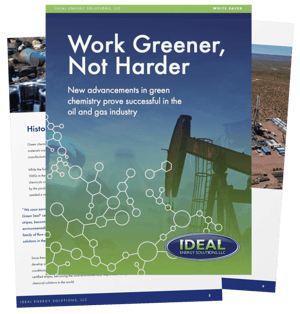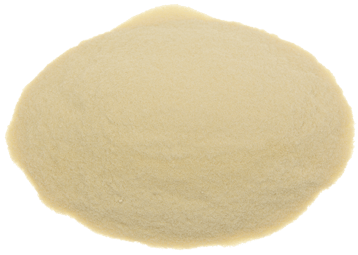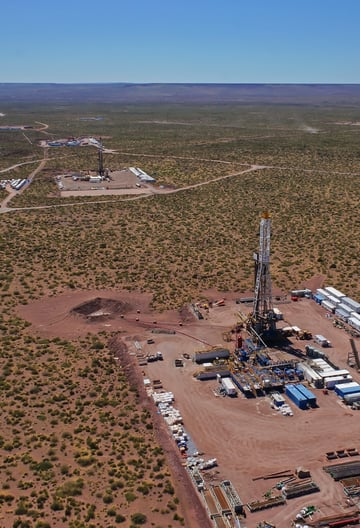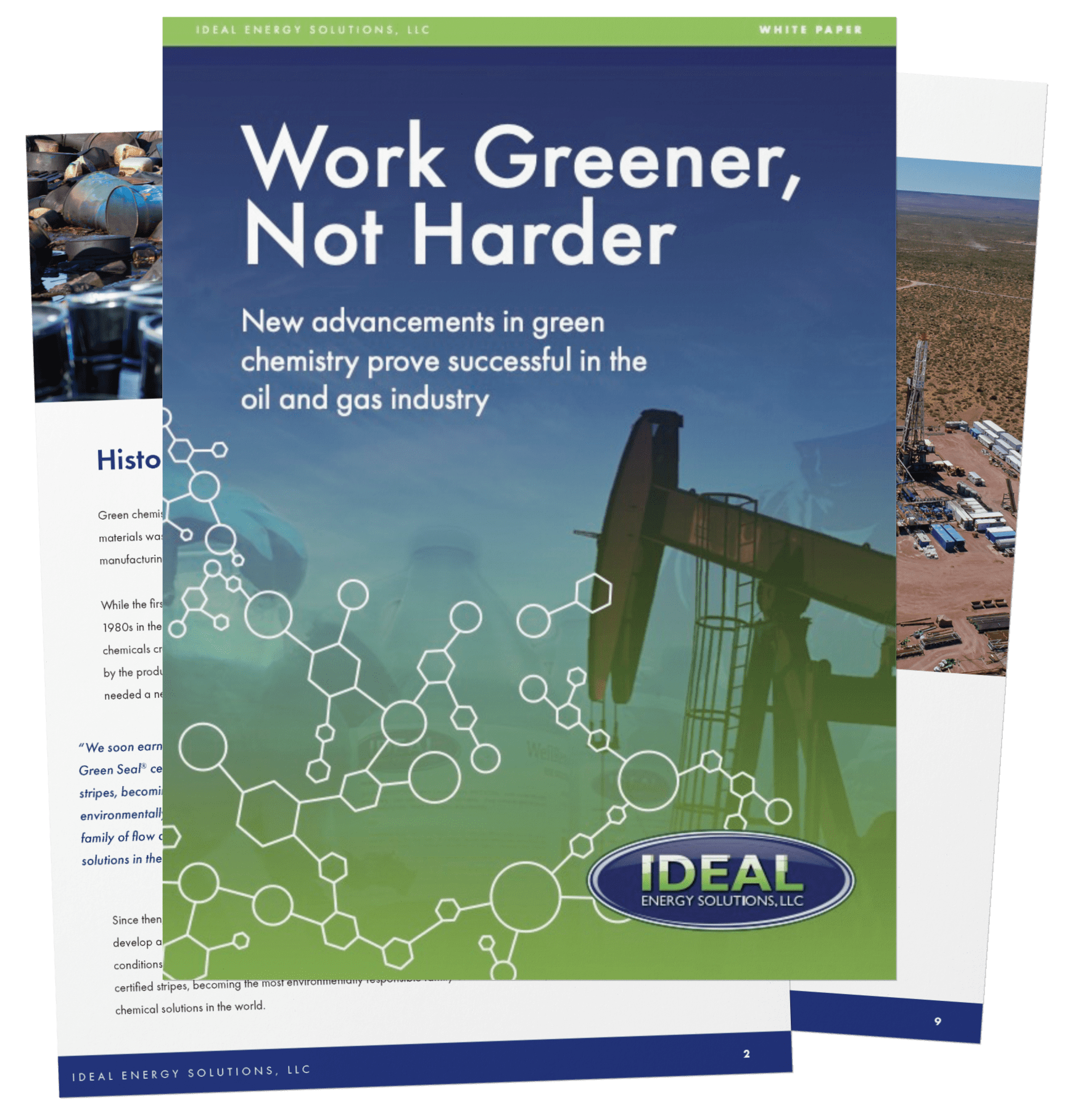WHITE PAPER
Work Greener,
Not Harder
New Advancements in Green Chemistry Prove Successful in the Oil and Gas Industry
WHITE PAPER
Work Greener,
Not Harder
New advancements in green chemistry prove successful in the oil and gas industry
TABLE OF CONTENTS:
Download the full White Paper:

The chemical industry and the oil and gas industry are inextricably tied together, dependent on each other on many levels.
Oil and gas production relies heavily on chemicals throughout drilling and extraction to transport and refine hydrocarbons. For example, at Ideal Energy Solutions, LLC ("Ideal"), we focus on developing green flow assurance chemicals for multiple segments within the oil and gas industry. Based in Lafayette, Louisiana, our proprietary suite of maintenance and remediation chemical products help ensure the flow of hydrocarbons from the reservoir to the refinery throughout the United States Gulf Coast and internationally.
Oilfield operations cannot eliminate the use of chemicals; the need for green, sustainable, eco-friendly chemicals is vital for the industry’s future. For over 30 years, research and application of green chemistry principles delivered successful alternatives to many of the most unsafe practices related to chemical use. Today, investors, regulators, and consumers expect businesses to operate within the high standards established by ESG governance practices, including the continued improvement of the sourcing, development, and application of chemicals.
While every business and industry is under scrutiny to improve practices and meet regulations, the energy sector is at the forefront of meeting and improving cleaner solutions for oil and gas exploration, drilling, and production. At Ideal, we developed our suite of oilfield chemical products with a solid commitment to environmental responsibility. Our patented green chemistry provides environmentally-responsible solutions to a volume of contacts in the E&P and midstream segments of the industry. The adaptation of oil and gas industry processes to green alternatives proved to be both successful and effective.
Green chemicals explicitly developed for the oil and gas industry are at the forefront of green alternatives. Many sustainable options now replace their hazardous counterparts with equal and sometimes even greater efficiency. Still, more work is needed for the oil and gas industry to meet environmental and safety standards that continue to evolve. The advancement of green chemistry is tied directly to the future of the oil and gas industry.
History of Green Chemistry
Green chemistry was born out of necessity. Chemical manufacturing was losing money. The disposal of waste materials was expensive, and production yielded far more waste than product, causing financial issues for manufacturing companies.
While the first mention of the environmental factor appeared in 1992, chemical waste problems arose earlier in the 1980s in the fine chemicals industry. Production of fine chemicals, pharmaceutical intermediates, and some bulk chemicals created tons more kgs of waste than product. The cost of waste disposal outweighed the revenues generated by the products, and many plants shut down due to problems with profitability. The chemistry industry realized they needed a new paradigm for efficiency in organic synthesis, minimizing waste, and avoiding toxic chemicals.
With increasing environmental awareness, the chemical industry began to focus on waste prevention at the source as opposed to waste remediation and pollution control. This initiative resulted in the U.S. Pollutions Prevention Act of 1990. This legislation represented a notable shift in the focus of environmental attention. Recognizing waste prevention at the source not only eliminates cost, but also strengthens economic competitiveness through more efficient use of raw materials. From this new focus, a new term was born – green chemistry.
Since then, progress has been made in green chemistry within oil and gas. In 2013, Ideal Energy Solutions, LLC set out to develop a cleaner, smarter, higher-performing alternative to traditional chemical solvents that produce hazardous conditions for people and the environment through the use of green chemistry. We soon earned our Green Seal Certified® designation, becoming the most environmentally responsible family of flow assurance preventative and remediation chemical solutions in the world.
What is Green Chemistry?
Green chemistry is a radical change in the design of chemicals. Also known as sustainable chemistry, it minimizes the use or generation of hazardous substances. Additionally, it reduces pollution at its source by lowering or eliminating the hazards of chemical feedstocks, reagents, solvents, and products. This process is unlike cleaning up pollution (also called remediation), which involves treating waste streams (end-of-the-pipe treatment) or clean-up of environmental spills and other releases.
Green chemistry applies across the life cycle of a chemical product, including its design, manufacture, use, and ultimate disposal. It is a philosophy that applies to all areas of chemistry, not a single discipline.
Benefits of green chemistry over traditional chemistry listed by the EPA include:
-
Prevention of pollution at the molecular level;
-
Application of innovative scientific solutions to real-world environmental problems;
-
Reduction at the source because it stops the generation of pollution;
-
Reduction of the negative impacts of chemical products and processes on human health and the environment;
-
Lessening and sometimes elimination of hazards from existing products and processes; and
-
Design of chemical products and processes to reduce their intrinsic hazards.
1. Support waste prevention: design chemical syntheses to prevent waste; leave no waste to treat or clean up.
2. Use atom economy: design syntheses so the final product contains the maximum proportion of the starting materials; waste few or no atoms.
3. Apply less hazardous chemical syntheses: design syntheses to use and generate substances with little or no toxicity to humans or the environment.
4. Design safer chemicals and products: design chemical products that are fully effective, yet have little or no toxicity.
5. Deploy safer solvents and reaction conditions: avoid using solvents, separation agents, or other auxiliary chemicals. If use of these chemicals is necessary, use safer ones.
6. Design for energy efficiency: run chemical reactions at room temperature and ambient pressure whenever possible.
7. Use renewable feedstocks: use starting materials (also known as feedstocks) that are renewable rather than consumable. The source of renewable feedstocks is often agricultural products or the wastes of other processes and the source of consumable feedstocks is often fossil fuels (petroleum, natural gas, or coal) or mining operations.
8. Reduce chemical derivatives: avoid blocking or protecting groups or any temporary modifications if possible. Derivatives use additional reagents and generate waste.
9. Use analysts, not stoichiometric reagents: minimize waste by using catalytic reactions. Catalysts are effective in small amounts, can carry out a single reaction many times, and are preferable to stoichiometric reagents, which are used excessively and carry out a reaction only once.
10. Design chemicals for degradation: design chemical products to break down into innocuous substances after use so that they do not accumulate in the environment.
11. Apply real-time analysis to prevent pollution: include in-process, real-time monitoring and control during syntheses to minimize or eliminate the formation of by-products.
12. Deploy safer chemistry for accident prevention: design chemicals and their physical forms (solid, liquid, or gas) to minimize the risk of chemical accidents, including explosions, fires, and environmental releases.
Green chemistry efficiently utilizes raw materials, eliminates waste, and avoids using toxic or hazardous reagents and solvents for manufacturing and applying chemical products. Green chemistry is primarily pollution prevention, rather than waste remediation. In the last 25 years, the concept has become firmly entrenched in both industry and academia.
With a new focus on green chemistry, industries that relied on chemicals for sourcing, production, and manufacturing changed their practices and found new ways to solve issues without the hazardous chemicals of the past. Since its inception, groundbreaking changes and improvements have been achieved through green chemistry, and many more advancements are on the horizon.
Oil and Gas and the Chemical Industry
Drilling for oil is a complex process with many steps and considerations regarding drilling equipment, formation stability, and the composition of individual hydrocarbons. Each drilling operation has particular requirements and limitations.
Producers use chemicals in the drilling and extraction process to manage these peculiarities. Because water is often produced alongside crude oil, the two must be separated, which requires chemicals. At Ideal, we provide chemical solutions to ensure the flow of hydrocarbons from the reservoir through wellbore chemical remediation. Our WellRenew® product removes paraffin wax and asphaltene blockages in downhole tubulars and stimulates formations to eliminate skin damage and enhance production.
Once hydrocarbons go through the separation process, they must be transported. Transferring hydrocarbons through tankers or pipelines requires chemicals to protect assets from hydrogen sulfide, carbon dioxide, and bacteria. Ideal’s PipeRenew® product removes paraffin wax and asphaltene blockages in any flowline or pipeline. Recently, ConocoPhillips solved a two-year plugging problem in an Eagle Ford oil pipeline in Texas using our PipeRenew® treatment.
-
Temperature independent:
Unlike solvents, WellRenew® can remove paraffin, asphaltenes, or mineral scales over a wide range of temperatures. -
Size independent: WellRenew® is not limited by the size or depth of the tubing, making it ideally suited for all applications.
-
Non-hazardous and environmentally responsible: WellRenew® is biodegradable and will not harm formations.
-
Flexible: WellRenew® is a non-hazardous product that is activated with fresh water or produced salt water.
-
Temperature independent:
PipeRenew® is effective at removing paraffin, asphaltenes, or mineral scales at temperatures below 34°F. -
Size independent: PipeRenew® can be used on pipelines of any size or length, making it ideally suitable for land and deep water applications.
-
Non-hazardous and environmentally responsible: PipeRenew® is biodegradable and will not harm formations.
-
Flexible: PipeRenew® is activated with sea water, produced water, or fresh water, and can be used for both land and offshore applications.
On the downstream side, refining facilities must also guard against corrosion by using corrosion inhibitors and coating agents to protect equipment. Every step of oil and gas exploration, transport, and production needs chemicals. The composition of each type of hydrocarbon determines its chemical needs, but chemicals are always required to produce hydrocarbons.
Concerns with Oilfield Chemicals
Many oil and gas operations are located near sensitive aquatic environments or population centers, making it possible for oilfield products to come in contact with soil and water—potentially above ground and in the water table. Any resulting product toxicity can damage the environment and human health. Therefore, using environmentally responsible chemicals is critical to prevent ecological damage and keep the surrounding community safe and healthy.
In addition to protecting areas surrounding oil and gas operations, keeping oilfield workers safe from hazardous chemicals is vital. It is important to ensure workers are safe from potential exposure to carcinogens, and OSHA-required practices protect workers from the dangers of toxic chemicals. When carefully implemented, the standards greatly reduce dangerous exposure. Additionally, switching to effective green chemicals lowers the cost of operations when strict standards are no longer necessary because green chemicals have fewer hazards.
Another environmental risk associated with oilfield chemicals is damage to the reservoir formation. Additives like scale inhibitors can cause fine particles in the flowing stream, which indicates a weakening formation causing sand in reservoir fluids. The use of some biocides causes reservoir souring. Hydrogen sulfide (H2S) production and formation plugging occur due to souring. H2S is a serious problem as it causes damage to reservoirs and life-threatening danger to oilfield workers when exposed. Because it is highly corrosive, more maintenance is required to reduce the potential risk of environmental disasters related to potential leaks and spills, which is a significant hazard.
The continued advancement of green chemistry works to solve these problems and many others. The ACS Green Chemistry Institute Oilfield Chemistry Roundtable (OCR) brings together industry leaders to collaborate on solutions for more effective green oilfield chemicals.
Chemicals and Green Solutions
Green chemistry works to develop many new and effective chemicals for use in the oil field. It also continues to improve formulations to minimize production costs and expand on functionality so that one product can function in more than one capacity with the same efficiency.
Some recent advancements include the extensive use of green polymers. Green polymers are like biopolymers, but their origin can be from natural sources or crude oil while still maintaining the essential elements of green chemistry. Green polymers’ ability to form intermolecular hydrogen bonds results in viscous solutions that gel in water and help control rheological properties and stability.
Green polymers prove successful as thickening agents in drilling fluids. Drilling fluids, friction reducers, and slurries are customized for each operation. These custom formulas lend themselves to more green chemistry experimentation and, as a result, success in transitioning to greener alternatives. Green gums, such as Guar gum, Xanthan gum, and other water-insoluble cellulose materials, used as additives in drilling mud perform as excellent:
-
- Loss control agents


- Viscosifiers
- Polymers
- Emulsifiers
- Stabilizers
- Mud system thickeners
- Suspending agents
- Loss control agents
Green chemistry improves more than just drilling fluids. New chemicals designed to prevent pollution and reduce toxicity are continually tested and developed to aid in every stage of production. Ideal’s LamKleen® specially formulated detergent solution cleans pipelines and equipment in preparation for hot work or in-place abandonment. The non-hazardous product penetrates organic deposits and removes hydrocarbon residuals. LamFlo®, which serves as a preventative treatment pipeline maintenance solution, is also non-hazardous as well as biodegradable and BTEX free.
Many green solutions are at work in the oil field, and new chemical technology is currently in the testing phase with promise for future use.
Our proprietary blended solvent is a treatment that lowers pour point and reduces viscosity to prevent future paraffin wax and asphaltene buildups.
Our specially formulated detergent solution that penetrates organic deposits and removes hydrocarbon residuals.
More developments in oilfield green chemistry include the following:
- Biocides reduce bacteria growth which can lead to corrosion and reservoir souring. Biocides are inherently hazardous as they are intended to kill microorganisms. Trials of Nitrogen Reducing, Sulfate Oxidation Bioexclusion Technology (NRSOB) in some shale basins show promise as a sustainable option. Phage bio-control and enzymes provide possibilities for future green solutions as biocides.
-
Chelating Agents reduce the effect of total dissolved solids in produced water. Replacing hazardous chelating agents with citric acid is widely used and successful, as well as naturally occurring carboxylic acids and iminodisuccinic acid. All green alternatives have improved biodegradability and no health hazards.
-
Clay Control Additives and formation stabilizers first used potassium chloride to protect from clay swelling. Today choline chloride is the most widely used clay stabilizer and is also known as vitamin B4.
-
Corrosion Inhibitors and Coating Materials control the destructive effects of corrosion. Corrosion causes economic losses and irreversible damage to metallic surfaces. Greener acid corrosion inhibitors like propoxylated propargyl are much safer. In addition, plant extracts offer promising alternatives to traditional acetylenic organics, fatty amines, and ammonium salts of the past.
- Demulsifiers are used during the separation process. However, most traditional demulsifiers result in pollution and environmental hazards. Plant extracts, some vegetable oils, and green polymers are effective demulsifiers, even under varied temperatures.
-
Scale Inhibitors treat scale development in a well, which inhibit oil and gas flow. Biobased polymers are replacing synthetic polymers with success. The dry product formulated from greener alternatives reduces many hazards, lowers VOC emissions, and is listed as EPA-DFE.
-
Solvents aid in heavy hydrocarbon removal by breaking emulsions. Many advancements in base solvents/carrier chemistry replace the diesel commonly used with hydrotreated distillate streams with improved health and safety profiles. Renewable streams using seed oils have shown promise in carrier chemistry as well.
-
Surfactants reduce the surface tensions between oil and water, allowing fluid to flow easier and disperse wax and asphaltenes. The original solvents used benzene, toluene, ethylbenzene and xylene (BTEX). Green solutions use oxyalkylated alcohols, sulfonates in water, methanol, or IPA/propylene glycol.
 New Green Technologies in the Oilfield
New Green Technologies in the Oilfield
In addition to developing safer oilfield chemicals, extensive geochemical analysis of rock formation predicts interactions with chemical additives. Every formation is unique, with different compositions of reservoir rock that require extensive testing before drilling. Modeling the addition of fluids and chemicals during the drilling process determines the chemical’s ability to increase production and limit formation damage. Testing to understand fluid-rock interactions will further prevent damage and instabilities during oil and gas production.
Fluid injected into the reservoir interacts with the formation rock and impacts the rock’s geochemical and geomechanical properties, weakening grain particles and generating sand while producing reservoir fluids. The concentration of minerals such as carbonates and clays in the formation rock affects the extent of interactions. Many fluid-rock formation interactions occur. Identifying the specific geochemical reactions and processes is crucial to managing the porosity and permeability of the formation.
Green Seal® of Approval
The demand for greener, safer practices means an abundance of new products and companies offering green alternatives. While they claim to have safer, greener products, it is hard to confirm their claims without extensive research and testing. In answer to the need for certainty, Green Seal® pioneered ecolabeling in the United States with a consumer-friendly seal to help buyers make safer, greener choices with confidence.
 For 30 years, Green Seal® has certified thousands of leading products and services to its rigorous health, environmental sustainability, and product performance standards. Today, the Green Seal® Certified mark is a universal symbol that a product or service meets the highest benchmark of health and environmental leadership. Some chemicals used in the oil and gas industry have the Green Seal® Certified designation, and many more are considered better because of their green chemistry development. Green chemistry is constantly growing and improving the efficiency of oil and gas chemicals.
For 30 years, Green Seal® has certified thousands of leading products and services to its rigorous health, environmental sustainability, and product performance standards. Today, the Green Seal® Certified mark is a universal symbol that a product or service meets the highest benchmark of health and environmental leadership. Some chemicals used in the oil and gas industry have the Green Seal® Certified designation, and many more are considered better because of their green chemistry development. Green chemistry is constantly growing and improving the efficiency of oil and gas chemicals.
Ideal Energy Solutions, LLC offers two Green Seal® Certified products:
PipeRenew® and WellRenew®. These products are environmentally responsible and adhere to rigorous performance, health, and environmental criteria. Our LamFlo® and LamKleen® products are also biodegradable and BTEX free.
Benefits of Implementing Green Chemistry
The initial benefit of advancing and utilizing green chemistry is reducing harm to people and the environment by minimizing waste and redesigning effective chemicals without hazardous consequences. Historically, the damaging results of harmful chemicals are well known. Operators do not want to contribute to the destruction of their surroundings or endanger lives. Utilizing green chemistry is safer for all involved, and everyone benefits when used.
Society has taken note of the damaging consequences of hazardous chemicals and their toll on the environment and the population. For example, operational regulations are now standard. Businesses must comply with environmental and safety criteria to operate. However, it has not only become required by law but is increasingly the right thing to do for an organization’s bottom line. With ESG practices firmly entrenched in business valuation and success, green and sustainable practices build profitability. As a result, investors look to invest in companies with best practices to reduce risk. For oil and gas, the commitment to ESG begins at the flow assurance level.
Green chemistry has grown and taken hold in all aspects of our lives. Its solutions and products perform efficiently and sometimes even better than their damaging counterparts. At Ideal Energy Solutions, we understand that firsthand. Our family of flow assurance preventative and remediation chemical solutions is not only environmentally responsible, but they also outperform all other competitors to flush out deposits that block downhole tubing and pipelines.
The practice and advancement of green chemistry must continue to expand and create sustainable solutions. We are proud to show our commitment to the environment. With the help of green chemistry, our flow assurance and production maintenance chemicals provide environmentally friendly solutions for the oil and gas industry, serving operations in offshore Gulf of Mexico, the United State, and international markets.
Thank you for reading! Take this White Paper with you:

For more information about how WellRenew®, PipeRenew®, LamFlo®, and LamKleen® can cost-effectively remove paraffin and asphaltenes from your pipelines, contact your Ideal Energy Solutions, LLC representative today.
.png?width=261&height=101&name=ideallogo2%20(2).png)



